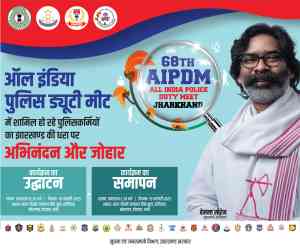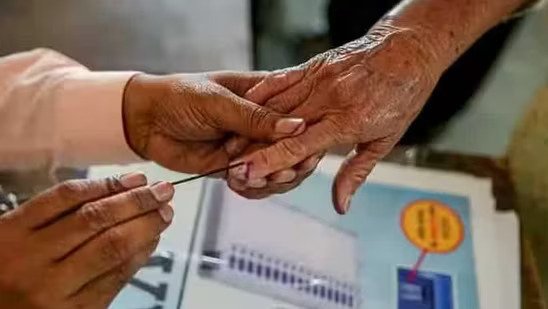
SWAMI DIVYAGYAN
Ranchi, Nov 3: The political stage is set in Lohardaga, where the game of electoral chess has begun in earnest. With the withdrawal process completed for assembly election nominations, the battlefield now hosts 17 candidates vying for the seat. Among them, three represent national and state-level political parties, six belong to registered political groups, and eight are independents. This multi-cornered contest promises to be a fascinating clash of tactics, alliances, and influence.
The primary face-off appears to be between Dr. Rameshwar Oraon of the Congress, currently serving as a state minister, and Neeru Shanti Bhagat, the NDA candidate and wife of the late MLA Kamal Kishore Bhagat. Dr. Oraon brings to the table the strong backing of the Congress, fortified by the support of prominent leaders like former Rajya Sabha MP and industrialist Dheeraj Prasad Sahu. This high-profile support boosts his campaign, making him a formidable contender. Meanwhile, Neeru Shanti Bhagat, standing on the legacy of her husband Kamal Kishore Bhagat, is expected to draw significant sympathy and support from voters loyal to her late husband’s political ideology.
Adding further intrigue to the equation is the presence of independent candidate Ramesh Oraon, a former BJP MLA who enjoys the backing of Hindu nationalist organizations like the Jai Shri Ram Committee. This backing, combined with his local influence, poses a challenge to the NDA by potentially splitting the Hindu vote bank. His candidacy forces the NDA to navigate an added layer of complexity, as his presence could divert traditional NDA votes, weakening Neeru Shanti Bhagat’s position.

Apart from these two, candidates from smaller parties like the Jharkhand Democratic Revolutionary Front and Jharkhand People’s Party are making the race even more interesting. Kishore Oraon of the Jharkhand Democratic Revolutionary Front, known to have influence among local tribal voters, and Anil Kumar Bhagat of the Jharkhand People’s Party, who is the brother of Neeru Shanti Bhagat’s late husband, have also thrown their hats into the ring. Anil’s candidacy reflects internal family rivalries and the complexities of local politics, as his involvement might fracture the support base that could have otherwise consolidated behind Neeru.
Also Read- Ticket distribution in Jharkhand Congress: Overlook of long-time supporters or influence of wealth?
Meanwhile, Congress has designed its campaign around government beneficiaries, seeking to transform welfare scheme recipients into a solid vote bank. Their strategy is to engage with these beneficiaries and their families, hoping to rally their support for Congress. Opposition parties, however, have criticized this move, accusing Congress of exploiting welfare beneficiaries for political gain. Whether this approach will yield favorable results for Congress remains to be seen, especially as the opposition scrutinizes and counters these tactics.
Among the notable newcomers in this race is Rajpati Devi from the Bharatiya Janajagaran Gandhian Party. Her unexpected entry into the political arena has surprised many and added a new dimension to the contest. Though her influence may be limited, her participation signals the expanding landscape of Lohardaga’s politics, transforming this into a multi-faceted competition.
The contest for tribal and Muslim votes is also fierce, with each party vying for their support. Congress is optimistic about securing the Muslim vote, which typically leans towards the Mahagathbandhan (grand alliance), but internal dissatisfaction among Muslim voters regarding the Congress candidate is evident. On the other side, the NDA is pulling out all stops to establish a stronghold in Lohardaga, hoping to woo tribal voters with extensive groundwork and outreach efforts.
The eight independent candidates in this election have added another layer of unpredictability. Candidates such as Birendra Oraon, Brij Mohan Oraon, and Ramesh Oraon are attempting to capture the attention of voters on the strength of local issues and personal appeal. Their presence has the potential to disrupt the vote calculations of major parties, as each of these candidates could attract a portion of the electorate, creating ripples in the established vote banks.
The backdrop of internal factionalism within major parties like BJP and Congress further intensifies this election. Many longstanding leaders within both parties have felt sidelined, leading to whispers of dissent and disunity. This internal discontent among seasoned party members may affect how effectively each party rallies its supporters.
With parties like BSP, Lokhit Adhikar Party, and People’s Party of India (Democratic) also fielding candidates, Lohardaga has become a rich political tapestry where every vote matters. The convergence of powerful individuals, family rivalries, welfare dynamics, and independent forces has created a web of intrigue and possibility.
In summary, the electoral chessboard in Lohardaga is set, with each player making calculated moves in the quest for political checkmate. This race is not merely about political strength or individual charisma but a test of strategy, local alliances, and how deeply each candidate connects with the voters. As the game unfolds, Lohardaga awaits its final verdict in what promises to be a gripping electoral battle.


